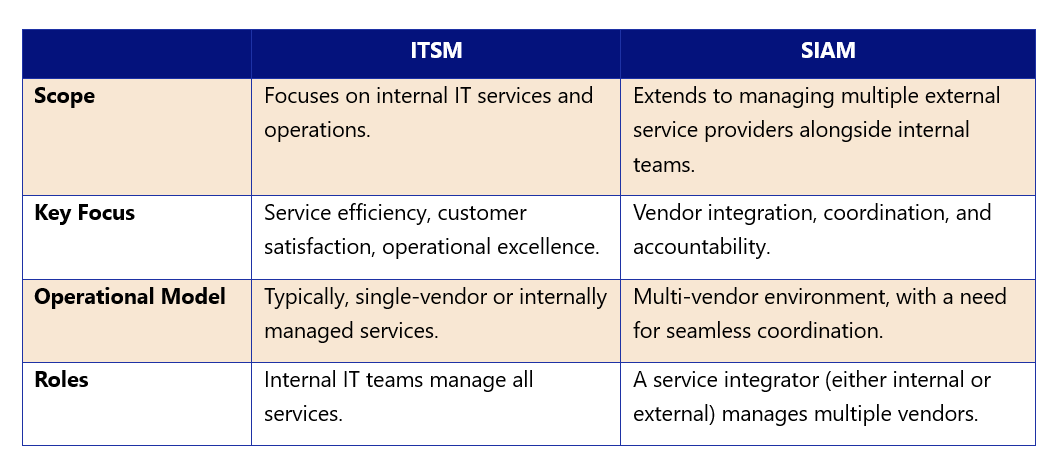The Subtle Dance of Service Management - ITSM vs SIAM
24/10/24, 10:00 am
Introduction
In today’s fast-paced digital landscape, businesses rely on a robust IT backbone to keep their operations running smoothly. From email systems to data storage, the modern enterprise is underpinned by a complex network of IT services. However, managing these services effectively can be a daunting challenge, especially when multiple service providers are involved. This is where the nuanced worlds of IT Service Management (ITSM) and Service Integration and Management (SIAM) come into play—two essential yet distinct approaches that shape how organisations orchestrate their IT ecosystems.
At first glance, both ITSM and SIAM may seem like different shades of the same colour—technical jargon thrown around in boardrooms and IT departments—but they represent two fundamentally different philosophies. ITSM focuses on the internal management of IT services, while SIAM grapples with the external challenge of coordinating multiple service providers. The difference between them is subtle yet critical, and understanding this distinction can mean the difference between seamless service delivery and a fragmented IT operation.
ITSM: The Art of Managing Internal Services
IT Service Management (ITSM) has long been the cornerstone of IT operations. It is a structured approach that helps organisations manage their own IT services, guiding everything from service design to daily operations. Here’s a quick breakdown of its key aspects:
Scope
ITSM revolves around internal IT processes and operations.
Focus
It is concerned with improving service delivery, operational efficiency, and user satisfaction.
Processes
Key processes include incident management, change management, problem management, and service-level agreements (SLAs).
Who it serves
ITSM primarily addresses the needs of an organisation's internal IT department, ensuring that IT services are delivered reliably and in alignment with business goals.
In essence, ITSM provides the blueprint for how an organisation manages its technology infrastructure. Whether it’s solving IT issues or managing change requests, ITSM ensures that services are delivered with minimal disruption, setting up a predictable and manageable environment.
SIAM: The Complex Symphony of Multi-Vendor Management
Now, as businesses increasingly outsource their IT functions to a growing number of service providers, managing this complex web of vendors becomes a whole different ballgame. Enter Service Integration and Management (SIAM). Here’s a quick breakdown of its key aspects:
Scope
Manage multiple service providers—both internal and external.
Focus
Ensure smooth service integration, coordinating various vendors to deliver a seamless experience.
Processes
SIAM governs vendor relationships, manages contracts, and holds service providers accountable for their performance.
Who it serves
SIAM serves organisations that rely on a mix of third-party vendors and internal teams, ensuring that all services work together harmoniously.
Where ITSM is about internal processes, SIAM orchestrates the efforts of multiple external providers to create a unified service delivery. It’s as if ITSM sets the rules for a well-run household, while SIAM manages the various service companies—the cleaners, the gardeners, the electricians—that keep the house in order.
Breaking down the differences
 These key differences highlight how each plays its role: ITSM establishes a controlled internal environment, while SIAM takes charge of orchestrating a more complex, multi-provider IT landscape.
These key differences highlight how each plays its role: ITSM establishes a controlled internal environment, while SIAM takes charge of orchestrating a more complex, multi-provider IT landscape.
Finding Harmony: Do You Need Both?
As organisations grow, so do their IT ecosystems. In many cases, IT departments are no longer the sole service providers, as outsourcing certain IT functions or adopting cloud services becomes increasingly common. This creates a delicate balance between internal and external management—one that requires both ITSM and SIAM.
While ITSM continues to provide the backbone of internal service management, SIAM steps in when multiple vendors are involved. For an organisation that has reached the tipping point of working with several external suppliers, the two approaches are not mutually exclusive but complementary. ITSM ensures your internal operations are running smoothly, while SIAM ensures your external partners are aligned and contributing to a unified service strategy.
Conclusion
As organisations navigate the increasingly complex landscape of IT service delivery, both ITSM and SIAM are likely to play a role. Whether you are managing internal services or coordinating a web of external vendors, these two approaches provide the framework needed to thrive in a digital-first world. For most organisations, adopting a blend of ITSM and SIAM will provide the agility, control, and coordination necessary to meet evolving business demands.




